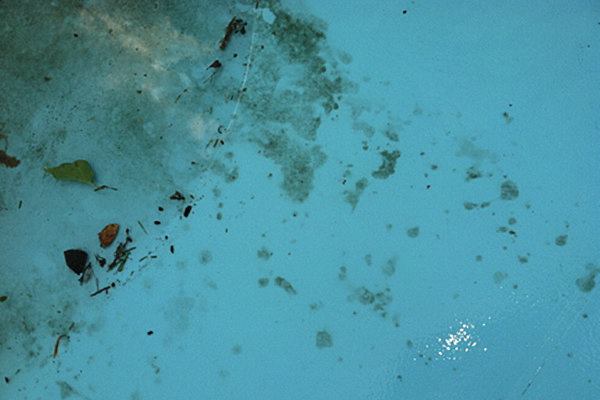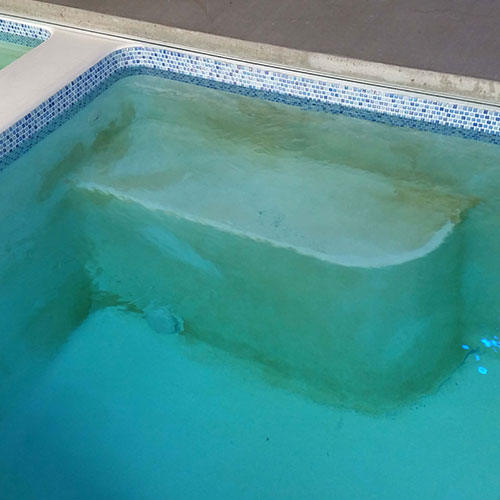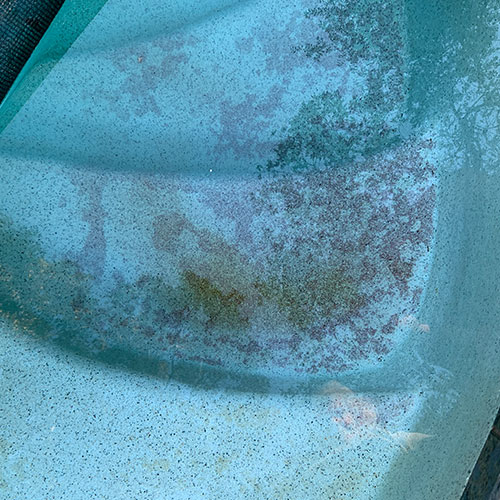Pool stains are a common problem no matter how well the pool is maintained. If left untreated, they can become unsightly and difficult to remove.
Fortunately, by identifying the right kind of stain, they can be removed with a little effort and patience. Also, you can take some measures to avoid staining from occurring in the first place!
Identifying and Testing the Stain
Before we try and eliminate the stain on the surfaces, it’s important to first identify what type of stain it is and what is causing it to show up in the first place.
Most stains are usually caused by organic contaminants and debris or by metals in the water.
Organic Stains
Organic stains in a pool are typically caused by leaves, algae, or other contaminants that may get into the water.
If they are allowed to settle on the surface, over a period of time they will leave stains on the surface.

Testing organic stains: If you suspect the surface stain to be organic, rub a trichlor puck directly on the stain for a couple of minutes. If it starts to lighten or is completely removed, it is organic. If not, you likely have something inorganic.
Metal Stains
Most pool owners don’t realize they have metal in the water until they notice stains on the surface. They usually will appear if pH is raised or when adding higher doses of chlorine.
In general, metals are almost always introduced into the water by the owner, either inadvertently or on purpose.
The two most common types of metal stains are caused from iron and copper. Manganese can also be found if the pool is filled with well water.
Causes of Iron Stains
Iron is a very common metal source in well water. If you happen to top off the pool with your well, the water likely contains iron. Over time, the iron levels become too large and can cause staining.

Testing iron stains: Typically, a high concentration of iron can cause light yellow stains and dark brown pool water. If you think the stain is iron, crush a bunch of vitamin C tablets and put them in a sock or nylon stocking. Rub it directly on a stain for a couple of minutes. If it lightens or disappears, then it is iron.
Causes of Copper Stains
In general, you do not want copper stains in your pool.
While it can also be found in well water, copper is typically caused by lower pH levels which can corrode copper plumbing.
Also, some algaecides, sanitizers, ionizers, and “shocks” will have quantities of copper in them. This is why it’s very important to know what chemicals are going into the pool.

Testing copper stains: Before the stains themselves, high concentrations of copper in the pool can cause hair and fingernails to turn green. If your golden retriever is now a dark green retriever, you know you have some issues. You can confirm a copper stain in the pool by putting some dry acid in a sock and rubbing it against the stain. Tie it to the end of a telescopic pole so you aren’t touching it directly.
Testing For Metal in the Water
Once there is a general idea that metals cause staining, you want to know how much metal you are dealing with in the water.
The best way is to test the water at a pool store. Generally, testing kits for metals can be pretty expensive for something that may only be necessary a handful of times. If testing for copper, ensure they can do a total copper test and not a free one.
Taylor offers a K-1264 test for copper and iron, though it typically retails for around $150-$200.
How to Remove Pool Stains
There is no telling how easy or difficult it may take to remove any stain. The good news is typically you don’t have to drain the water to remove most copper stains.
However, it largely depends on how much staining has occurred, how old the stain is, and the overall type. Let’s go through tackling the three stains mentioned above.
Removing Organic Stains
Removing an organic stain is a relatively simple process. After all, since chlorine attacks organics, the solution is to add chlorine.
Shocking the pool and raising chlorine to shock levels based on your current CYA reading is preferred. During this time, brush the pool often and keep the pool pump running.
Keep brushing until the stains are no longer visible and the water is clear. Follow the shocking process and stop until testing proves the water is balanced.
Removing Iron Stains
Iron stains can be removed using vitamins C tablets, also known as ascorbic acid. If the stains are relatively small, crush some vitamin C tablets in a sock and rub them against the stain. However, if the stains have started to take over the pool, you’ll need a larger ascorbic acid treatment.
TroubleFreePool has a great guide on an ascorbic acid treatment for larger stains. Follow these steps:
- Lower pH to 7.2 using muriatic acid. Note that total alkalinity (TA) will also go down but that is OK
- Don’t start until chlorine is 0 or close to 0. Chlorine will attack the ascorbic acid so the less in the pool, the less acid you’ll need to use.
- Add about 0.5 pounds of ascorbic acid per 10,000 gallons. Start out smaller and see if stains start to disappear. Otherwise, increase to 1 pound.
- If your filter allows, set the multiport valve to Recirculate. This bypasses the filter altogether. If using a cartridge filter, remove the cartridges. The goal is for no ascorbic acid to get caught in any filter grids.
- Let the acid circulate for about half an hour. It should start to work, and you might see the stains start to disappear.
- If there are more stubborn stains, apply more ascorbic acid to the area, keep the filter on, and recirculate until the stain is gone.
- Once the stains are gone, use a sequestering agent to prevent future staining (more on that below!)
- After 24 hours, test and balance the water using the correct pool chemicals.
- Refer to the TroubleFreePool guide on how to rebalance the pool slowly. Go to the “After AA Treatment” section, as there are some delicacies on ensuring stains do not come back
Removing Copper Stains
Do not use ascorbic acid to remove copper stains in the pool! It can further oxidize the copper, increasing the difficulty of removal.
Copper stains can be removed using sulfamic acid, an acidic descaling agent. While very effective at removing stains, it will affect overall water chemistry, so be prepared to rebalance the pool after it is complete.
Jack’s Magic #2 Copper and Scale Stuff is a sulfamic acid product for removal.
This should go without saying but do not swim during this treatment process.
Jack’s Magic has a great guide (opens a PDF) for this treatment procedure. You’ll also want Jack’s Magic The Blue Stuff for a copper sequestrant.
Preventing Stains
Let’s make one important distinction: removing stains does not remove the metal in the water.
The only realistic solution for removing metal is to replace it with fresh water. However, there are various ways we can use to both restrict the damage of metals and prevent them from ever entering the water as much as possible.
Prevent Organic Stains
The best way to prevent organics from staining the pool surface is to test and maintain the pool on a weekly schedule properly.
Keep your water balanced with a proper testing kit and pool chemicals. Clean the pool by brushing and vacuuming weekly.
If leaves or debris get into the pool, remove them with a skimmer net before they have a chance to reach the floor and cause a stain.
Prevent Metal Stains
As stated above, the pool owner introduces most metals into the water. Ideally, it would be great if fresh water could get trucked in whenever needed, but that is not the reality.
It is very important to know and understand everything that gets into the pool, from chemicals to water.
- Maintain proper water balance at all times. A low pH in particular will make the water more acidic which can cause the corrosion of metal pipes.
- Look at your daily chemicals and check the ingredients. Most algaecides will contain copper, as well as some trichlor tablets. Pool ionizers and mineral systems use copper to treat and fight algae. Also, any pool product with “Blue” in the name will typically contain copper
- Check on your pool plumbing and make sure there’s no rusting. If you have a heater with copper heat exchangers, inspect them frequently for corrosion and replace any deteriorated pipes when you spot them.
- Check your most frequently used water source for metals. Whether from a personal well or municipal water, knowing what’s being poured into the pool is good. Doing a full test for all parameters is recommended just for extra clarity.
- If there are metals present in the water source, use a hose filter to catch as much of the metal as possible before it gets into the pool
- Use a metal sequestrant in the pool. While sequestrants are not stain removers and cannot get rid of metals, they “bind” with them so they can’t form surface stains in the first place.
- For iron, use Jack’s Magic The Pink Stuff
- For copper, use Jack’s Magic The Blue Stuff or ProTeam’s Metal Magic
- Saltwater pool owners can use Jack’s Magic The Purple Stuff
Remain Stain Free!
Stains are never fun to find and deal with. Not only does it make the pool surface look ugly, it prevents you from actually enjoying the pool.
Keep testing and maintain a good cleaning schedule, have some sequestrant handy at all times, and hopefully stains are something you never have to encounter.



